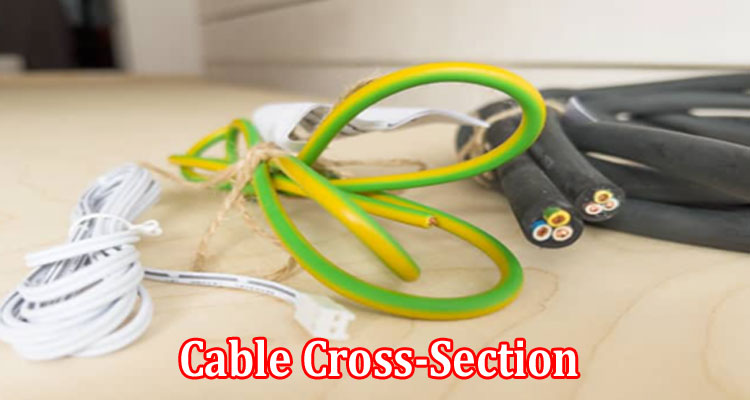A cable cross-section that is too small or a power cable that is too thin can destroy your 12V camper electronics and, in the worst case, lead to a cable fire.
To prevent this, calculate the correct cable cross-sections when wiring your electrical motorhome.
What is the cable cross-section, and why is it important for your RV electrical system?
Before you calculate the right 12 V, 24 V, or 230 V cable cross-section, you should first understand what a cable cross-section (also called wire cross-section) is.
The cable cross-section refers to the pure conductor area of the strands, which is created as soon as you cut your cable in the middle.
The cable diameter is made up of the cable cross-section AND the insulation.
Since the insulation thickness and, thus, the cable diameter is of secondary importance to us, we always refer to the cable cross-section when calculating your cables in this article.
Why is the correct cable cross-section so important?
1. Too much voltage loss
Copper, as a material, has a certain resistance that the current has to overcome on its way from your RV battery to the consumer.
So when current flows through the wiring in your camper, there are voltage losses due to resistance.
If you have chosen too small a cable cross-section for the solar panels system in your mobile home, there will be too little voltage at the end of the line due to voltage dips because there is too much loss in the lines. It can then happen that your connected consumer at the end of the line no longer receives the required voltage and therefore does not work. And that is exactly what needs to be avoided because we want an efficient energy supply in the camper.
2. Extreme heat and risk of cable fire
The wrong voltage at the consumer is only the second most important factor why you should calculate your cable cross-sections correctly.
Voltage drops (also known as voltage drops in the past) manifest as heat. This heat in your power cables can cause your cable to catch fire and cause a vehicle fire if the cable cross-sections are too small!
Other factors why you should calculate the correct cable cross-section for your camper electronics:
Large cable cross-sections and, thus, thick copper cables now cost a lot of money. If you have chosen the right cable cross-section, you save money.
Depending on the size of the mobile home and the electrical equipment, more than 100 m of the power cable is often laid in a camper. Of course, that can count! Every gram counts, especially when you need to save on the overall weight of your vehicle.
Which cable material and which cable length and cross-section size should you use for your motorhome electrical system?
Please never use rigid copper lines in your camper, as you may be familiar with them from home. These can eventually break due to the vibration of your motorhome and cause cable fires!
Instead, always use “elastic” cables with copper strands and the appropriate approval label. Bought from reputable dealers, these are always flexible and permitted for installation in cars or mobile homes.
You should always keep your lines as short as possible and as long as necessary. On the one hand, you save weight and money. On the other hand, the voltage drop is, of course, lower with shorter cables. This applies to laying solar cables and connecting your 230V inverter to 12 volt battery.
Calculate the cable cross-section for your 12V motorhome electrics – using tables and online calculators. You can also read your required cable cross-section or line cross-section from various tables without any calculations.
Voltage (drop) drop (dissipation factor)
When calculating your cable cross-section, the voltage or the desired maximum voltage drop in the cable also plays an important role.
Roughly speaking, every power cable that leads from your battery to the consumers in your motorhome also represents resistance. The current flowing through the cable must overcome this resistance.
Naturally, there are losses. So your consumer rarely gets the full 12 V that your battery sends through the power cable. The longer your cables, the higher the resistance in these cables. That’s why the following applies: the shorter your cable, the better!
So that you don’t lose electricity from A to B, it is important to keep the voltage drop and, thus, the desired loss factor as low as possible!
You should not plan more than 4% here. Less is, of course, better, and depending on the sensitivity of your devices (e.g., laptop charger), you cannot allow yourself 4%! However, a small loss factor reduces the cable length, or the cable cross-section increases!
Calculate the formula for cable cross-section
You can also calculate the cable cross-section for your mobile home electrics by hand!
A = ( I x lmax x 2 ) / (Δu x UN x 57.18)
I am the maximum current in amperes.
lmax is the cable length in one direction (hence the multiplication by 2 for the “return path”)
Δu (Delta-U) is the loss factor; for example 3% (0.03) voltage drop
UN is the voltage (e.g., 12 volts)
57.18 represents the specific resistance of copper in ohms x mm2 / m. We don’t have to worry about this fixed value further :-).
What you should consider when laying your power cables in the camper
Using our table and the online solar powered calculator, you have calculated the right cable cross-sections for your 12 V camper electrics. Now it’s time to lay your power cables in the motorhome. Here are a few pointers to keep in mind:
- Never misplace! Cables for your 230 V system and your 12 V cables in the same conduit or directly next to each other (without insulation in between) in the vehicle. It would help if you always separated these cables, for example, by using cable conduits provided for this purpose^, to avoid voltage transfer between the individual circuits.
- Of course, the same also applies to the junction boxes^: Here, you should never distribute 230 V cables together with the 12 V cables, as this does not separate the cables.
- Always lay the lines of your camper electronics in a vibration-proof manner. Watch for sharp edges and use edge protection^ if you run the cables through holes. It is best to always use a conduit for your cables. So you are on the safe side.
- Electrical cables also have no place in the area of your gas system. Never lay pipes through your gas box. The danger of explosion here!




